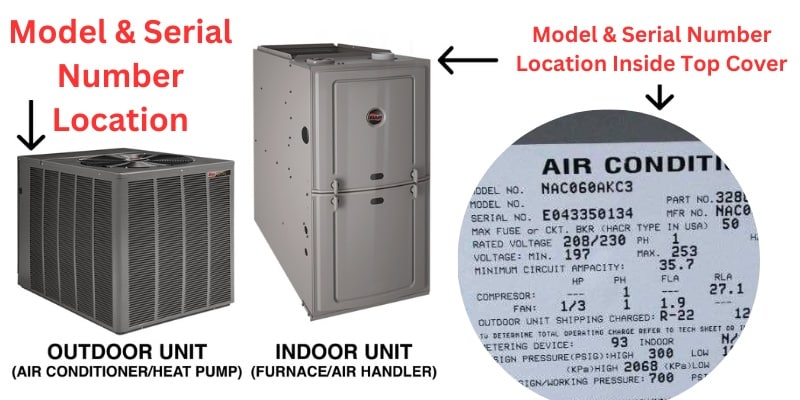As an experienced HVAC technician, I can attest to the paramount importance of model numbers when dealing with HVAC equipment. One of the leading brands in the HVAC industry, Ruud, designs its model numbers to provide professionals like us with a quick overview of the equipment’s specifics. One of the most crucial pieces of information encoded within the Ruud model number is the size or tonnage of the unit.
Ruud and Rheem’s model numbers are very similar, if not nearly identical, in many cases. This similarity stems from the fact that both brands fall under the same parent company. Over the years, while Rheem and Ruud have maintained distinct brand identities in terms of marketing and product positioning, many of their HVAC products have been produced using similar designs and specifications.
Because of this shared lineage, their model number structure tends to encode the same kind of information, such as size/tonnage, efficiency ratings, and other key features. For HVAC technicians and homeowners, this means that if you’re familiar with decoding one brand’s model number, you’ll likely be able to decode the others with the same ease.
Ruud Model Number Lookup
Every Ruud model number is meticulously structured to offer a snapshot of the unit’s details. These numbers aren’t arbitrary sequences but are a compilation of various unit specifications laid out systematically.

- Series Identification
Each Ruud HVAC unit, whether it’s an air conditioner, heat pump, or furnace, has a unique identifier within the model number, helping technicians quickly discern the product line. - Size/Tonnage
Arguably, the most essential aspect for us HVAC professionals is the size or tonnage. Embedded within the Ruud model number, this indicates the unit’s cooling capacity. It’s vital to correctly identify this to ensure that the unit serves the intended space optimally and operates at peak efficiency. Incorrect sizing can lead to reduced efficiency, shorter equipment lifespan, and even comfort issues for the occupants. - Efficiency Rating
By examining the model number, one can determine the SEER (Seasonal Energy Efficiency Ratio) or HSPF (Heating Seasonal Performance Factor) rating of the unit. This helps gauge the operational efficiency of the equipment. - Features
Advanced features, such as the Inverter-Driven Variable Speed Compressor, can be discerned from specific segments within the model number. Being able to identify these can be crucial when diagnosing issues or determining the unit’s capabilities.
To determine the age of your unit, please refer to another article I’ve written. It provides detailed steps and information to help you accurately gauge the age of your Ruud HVAC system.
How do I know my Ruud HVAC tonnage?
While the structure remains consistent, model numbers may have slight variations between product lines or even between residential and commercial models.
To ascertain the tonnage of your Ruud HVAC system, inspect the model number. Focus on the second set of numbers within the model number.
This figure will typically be divisible by 6 or 12, signifying the system’s nominal BTU in the thousands. Given that one ton of air conditioning corresponds to 12,000 BTU, and using the equation 24 divided by 12 results in 2, the information on the label suggests that the system has a capacity of 2 tons.
- RA1436AJ1NA is a 3-ton, single-stage Air Conditioner with RA14 refrigerant.
- RACC-036JAS is a 3-ton furnace.
Why Model Numbers Matter
- Size/Tonnage: Correctly identifying the capacity ensures that the HVAC system is right for the space and will operate at its peak.
- Replacement Parts: A model number is your roadmap to compatibility, ensuring that you order or replace parts that will seamlessly fit and function.
- Service and Repairs: Even before popping open a unit, its model number can offer insights into potential issues or vulnerabilities.
- Upgrades and Replacements: When advising clients on potential upgrades or replacements, the model number provides a baseline for comparison.
- Warranty Claims: In cases where a warranty claim may be necessary, the model number expedites the process by offering an immediate reference.
Tips for Locating the Model Number on Your Ruud HVAC Unit
Most often, Ruud places its model number on a sticker or plate on the side or back of the unit. While accessing this, always ensure the unit is powered off, and if outdoors, consider potential environmental factors (rain, snow, etc.) that might make conditions slippery or hazardous.

Understanding how to decode the Ruud model number is not just about proficiency; it’s about ensuring that, as HVAC technicians, we deliver the best service, make informed decisions, and provide optimal solutions for our clients. Always have the model number at the ready—it’s an invaluable tool in our HVAC toolkit.






